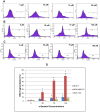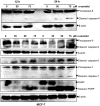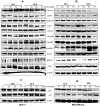Antineoplastic effects of α-santalol on estrogen receptor-positive and estrogen receptor-negative breast cancer cells through cell cycle arrest at G2/M phase and induction of apoptosis
- PMID: 23451128
- PMCID: PMC3579946
- DOI: 10.1371/journal.pone.0056982
Antineoplastic effects of α-santalol on estrogen receptor-positive and estrogen receptor-negative breast cancer cells through cell cycle arrest at G2/M phase and induction of apoptosis
Erratum in
- PLoS One. 2013;8(6). doi:10.1371/annotation/c732480c-eb97-4eff-acb6-300797f4efa9
Abstract
Anticancer efficacy and the mechanism of action of α-santalol, a terpenoid isolated from sandalwood oil, were investigated in human breast cancer cells by using p53 wild-type MCF-7 cells as a model for estrogen receptor (ER)-positive and p53 mutated MDA-MB-231 cells as a model for ER-negative breast cancer. α-Santalol inhibited cell viability and proliferation in a concentration and time-dependent manner in both cells regardless of their ER and/or p53 status. However, α-santalol produced relatively less toxic effect on normal breast epithelial cell line, MCF-10A. It induced G2/M cell cycle arrest and apoptosis in both MCF-7 and MDA-MB-231 cells. Cell cycle arrest induced by α-santalol was associated with changes in the protein levels of BRCA1, Chk1, G2/M regulatory cyclins, Cyclin dependent kinases (CDKs), Cell division cycle 25B (Cdc25B), Cdc25C and Ser-216 phosphorylation of Cdc25C. An up-regulated expression of CDK inhibitor p21 along with suppressed expression of mutated p53 was observed in MDA-MB-231 cells treated with α-santalol. On the contrary, α-santalol did not increase the expression of wild-type p53 and p21 in MCF-7 cells. In addition, α-santalol induced extrinsic and intrinsic pathways of apoptosis in both cells with activation of caspase-8 and caspase-9. It led to the activation of the executioner caspase-6 and caspase-7 in α-santalol-treated MCF-7 cells and caspase-3 and caspase-6 in MDA-MB-231 cells along with strong cleavage of poly(ADP-ribose) polymerase (PARP) in both cells. Taken together, this study for the first time identified strong anti-neoplastic effects of α-santalol against both ER-positive and ER-negative breast cancer cells.
Conflict of interest statement
Figures







Similar articles
-
Survivin Down-regulation by α-Santalol Is Not Mediated Through PI3K-AKT Pathway in Human Breast Cancer Cells.Anticancer Res. 2015 Oct;35(10):5353-7. Anticancer Res. 2015. PMID: 26408696
-
Induction of Fas-mediated extrinsic apoptosis, p21WAF1-related G2/M cell cycle arrest and ROS generation by costunolide in estrogen receptor-negative breast cancer cells, MDA-MB-231.Mol Cell Biochem. 2012 Apr;363(1-2):119-28. doi: 10.1007/s11010-011-1164-z. Epub 2011 Dec 7. Mol Cell Biochem. 2012. PMID: 22147197
-
Alpha-santalol, a chemopreventive agent against skin cancer, causes G2/M cell cycle arrest in both p53-mutated human epidermoid carcinoma A431 cells and p53 wild-type human melanoma UACC-62 cells.BMC Res Notes. 2010 Aug 3;3:220. doi: 10.1186/1756-0500-3-220. BMC Res Notes. 2010. PMID: 20682067 Free PMC article.
-
Skin cancer chemoprevention by α-santalol.Front Biosci (Schol Ed). 2011 Jan 1;3(2):777-87. doi: 10.2741/s186. Front Biosci (Schol Ed). 2011. PMID: 21196411 Review.
-
Antitumor and chemopreventive role of major phytochemicals against breast cancer development.Nat Prod Res. 2024 Oct;38(20):3623-3643. doi: 10.1080/14786419.2023.2251167. Epub 2023 Aug 30. Nat Prod Res. 2024. PMID: 37646820 Review.
Cited by
-
Natural Products and Synthetic Analogs as a Source of Antitumor Drugs.Biomolecules. 2019 Nov 1;9(11):679. doi: 10.3390/biom9110679. Biomolecules. 2019. PMID: 31683894 Free PMC article. Review.
-
Antifungal and Cytotoxic Activities of Sixty Commercially-Available Essential Oils.Molecules. 2018 Jun 27;23(7):1549. doi: 10.3390/molecules23071549. Molecules. 2018. PMID: 29954086 Free PMC article.
-
Glyoxalase I inhibition induces apoptosis in irradiated MCF-7 cells via a novel mechanism involving Hsp27, p53 and NF-κB.Br J Cancer. 2014 Jul 15;111(2):395-406. doi: 10.1038/bjc.2014.280. Epub 2014 Jun 10. Br J Cancer. 2014. Retraction in: Br J Cancer. 2025 Jun;132(11):1084. doi: 10.1038/s41416-025-03042-0. PMID: 24918814 Free PMC article. Retracted.
-
Antineoplastic Effects of Honokiol on Melanoma.Biomed Res Int. 2017;2017:5496398. doi: 10.1155/2017/5496398. Epub 2017 Jan 17. Biomed Res Int. 2017. PMID: 28194418 Free PMC article.
-
Emerging Anti-Mitotic Activities and Other Bioactivities of Sesquiterpene Compounds upon Human Cells.Molecules. 2017 Mar 13;22(3):459. doi: 10.3390/molecules22030459. Molecules. 2017. PMID: 28335397 Free PMC article. Review.
References
-
- Zhang X, Dwivedi C (2011) Skin cancer chemoprevention by α-santalol. Front Biosci (Schol Ed) 3: 777–787. - PubMed
-
- Burdock GA, Carabin IG (2008) Safety assessment of sandalwood oil (Santalum album L.) Food Chem Toxicol. 46: 421–432. - PubMed
-
- Dwivedi C, Guan X, Harmsen WL, Voss AL, Goetz-Parten DE, et al. (2003) Chemopreventive effects of α-santalol on skin tumor development in CD-1 and SENCAR mice. Cancer Epidemiol Biomarkers Prev 12: 151–156. - PubMed
-
- Dwivedi C, Valluri HB, Guan X, Agarwal R (2006) Chemopreventive effects of α-santalol on ultraviolet B radiation-induced skin tumor development in SKH-1 hairless mice. Carcinogenesis 27: 1917–1922. - PubMed
-
- Kaur M, Agarwal C, Singh RP, Dwivedi C, Agarwal R (2005) Skin cancer chemopreventive agent, α-santalol, induces apoptotic death of human epidermoid carcinoma A431 cells via caspase activation together with dissipation of mitochondrial membrane potential and cytochrome c release. Carcinogenesis 26: 369–380. - PubMed
Publication types
MeSH terms
Substances
LinkOut - more resources
Full Text Sources
Other Literature Sources
Medical
Molecular Biology Databases
Research Materials
Miscellaneous

